Analysis of Teamwork, Power Dynamics, and Organisational Culture
VerifiedAdded on 2020/07/22
|13
|3529
|132
Report
AI Summary
This report provides an in-depth analysis of teamwork effectiveness, power dynamics, and their impact on organizational culture, using the Panda company as a case study. It begins by defining the importance of teamwork, work groups, and their positive impacts on organizations, supported by Tuckman's and Belbin's theories. The report further explores the influence of power and politics on teams, highlighting both positive and negative effects, and discusses how leadership can affect employee motivation and conflict resolution. Furthermore, it analyzes the organizational culture of Panda using Schein's and Handy's models, to examine the impact of power, task culture, and employee behavior. The report concludes by emphasizing the importance of managing power and politics to foster a positive work environment and enhance team performance. Overall, the report offers valuable insights into organizational behavior and management practices.
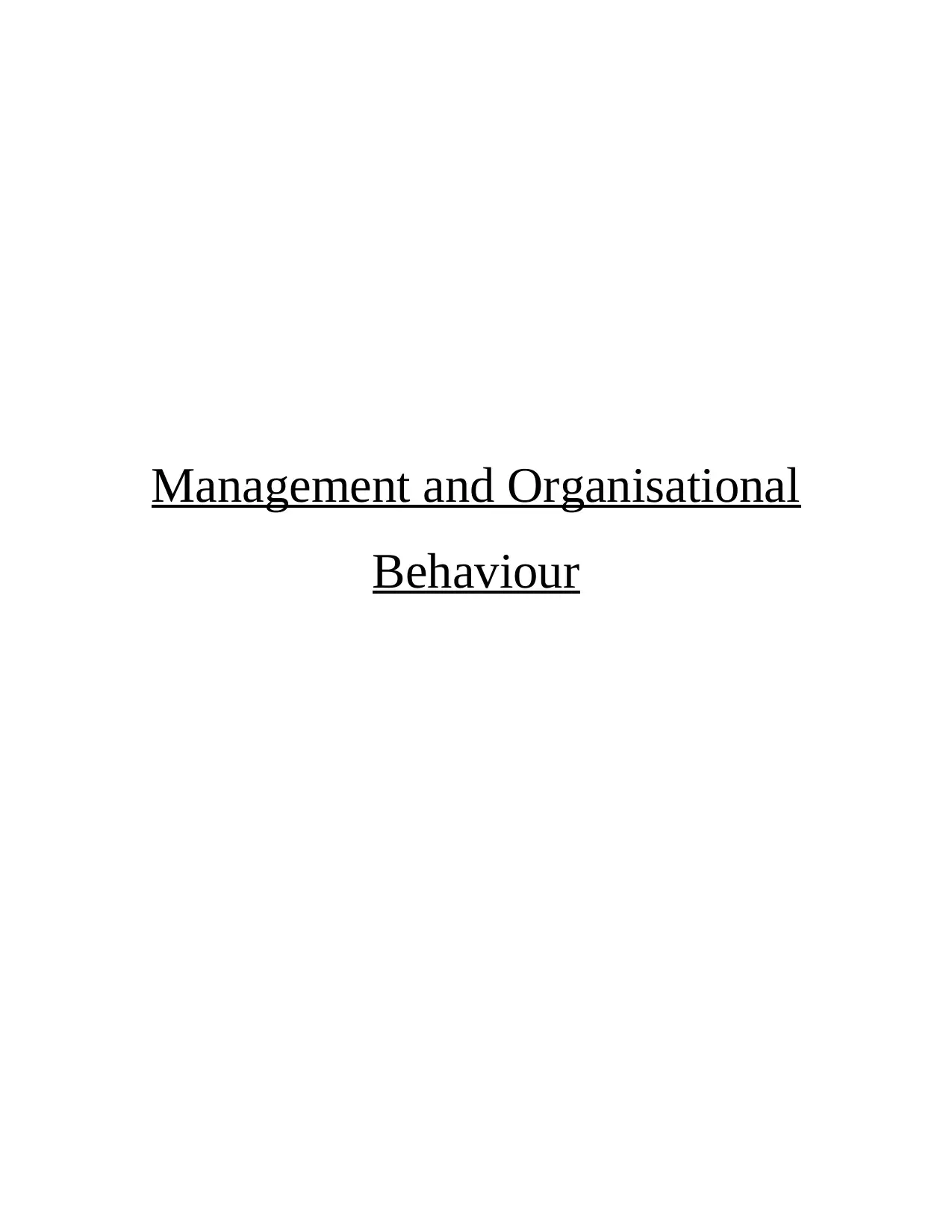
Management and Organisational
Behaviour
Behaviour
Paraphrase This Document
Need a fresh take? Get an instant paraphrase of this document with our AI Paraphraser
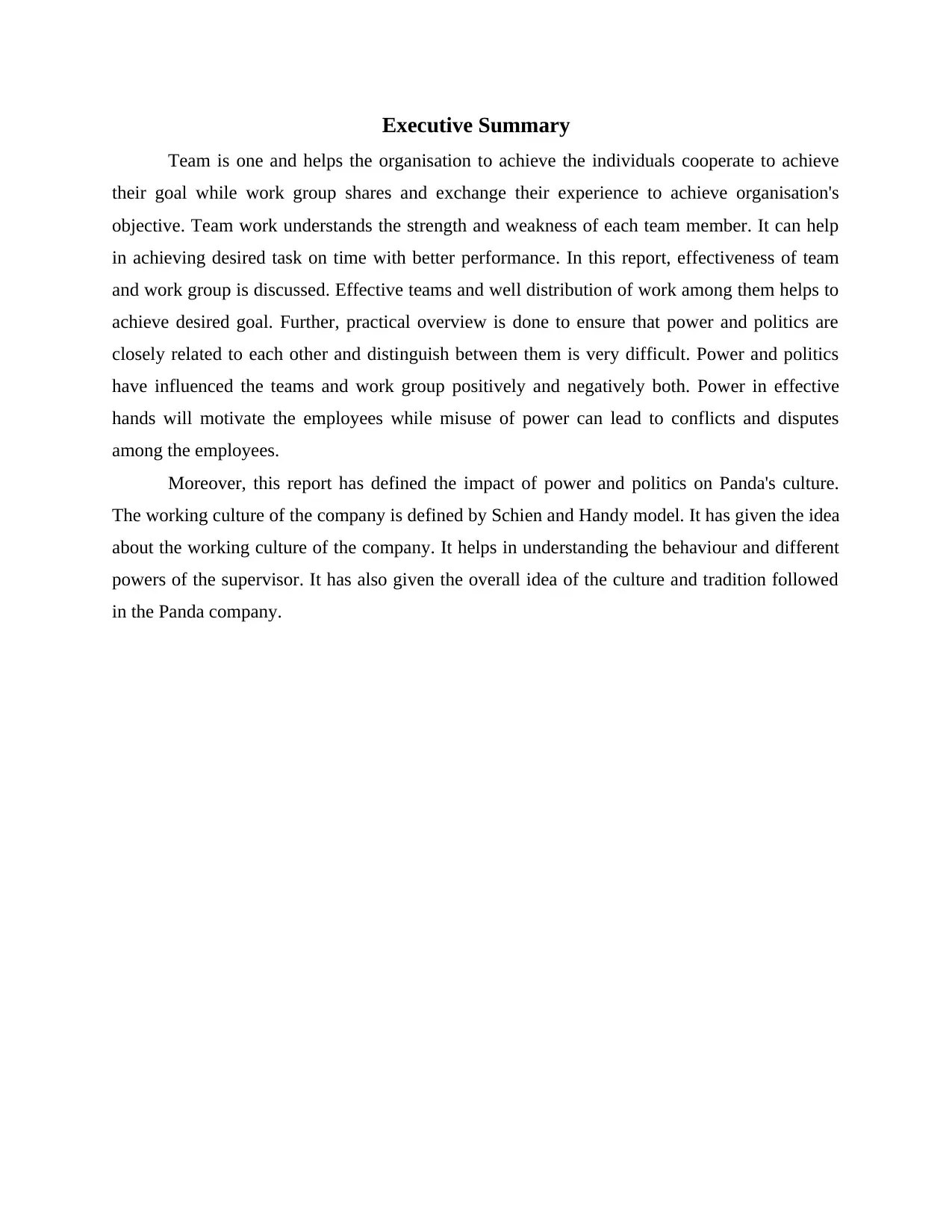
Executive Summary
Team is one and helps the organisation to achieve the individuals cooperate to achieve
their goal while work group shares and exchange their experience to achieve organisation's
objective. Team work understands the strength and weakness of each team member. It can help
in achieving desired task on time with better performance. In this report, effectiveness of team
and work group is discussed. Effective teams and well distribution of work among them helps to
achieve desired goal. Further, practical overview is done to ensure that power and politics are
closely related to each other and distinguish between them is very difficult. Power and politics
have influenced the teams and work group positively and negatively both. Power in effective
hands will motivate the employees while misuse of power can lead to conflicts and disputes
among the employees.
Moreover, this report has defined the impact of power and politics on Panda's culture.
The working culture of the company is defined by Schien and Handy model. It has given the idea
about the working culture of the company. It helps in understanding the behaviour and different
powers of the supervisor. It has also given the overall idea of the culture and tradition followed
in the Panda company.
Team is one and helps the organisation to achieve the individuals cooperate to achieve
their goal while work group shares and exchange their experience to achieve organisation's
objective. Team work understands the strength and weakness of each team member. It can help
in achieving desired task on time with better performance. In this report, effectiveness of team
and work group is discussed. Effective teams and well distribution of work among them helps to
achieve desired goal. Further, practical overview is done to ensure that power and politics are
closely related to each other and distinguish between them is very difficult. Power and politics
have influenced the teams and work group positively and negatively both. Power in effective
hands will motivate the employees while misuse of power can lead to conflicts and disputes
among the employees.
Moreover, this report has defined the impact of power and politics on Panda's culture.
The working culture of the company is defined by Schien and Handy model. It has given the idea
about the working culture of the company. It helps in understanding the behaviour and different
powers of the supervisor. It has also given the overall idea of the culture and tradition followed
in the Panda company.
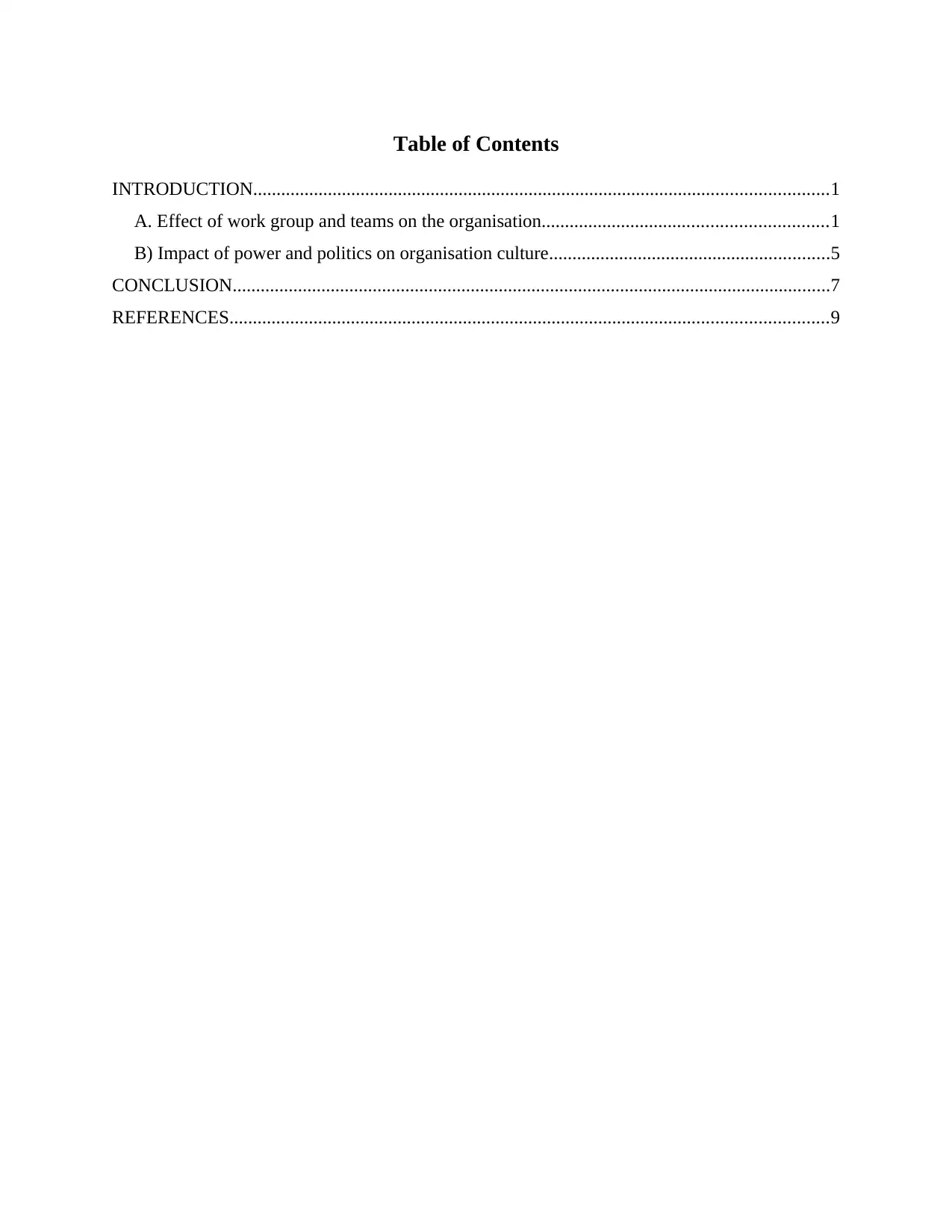
Table of Contents
INTRODUCTION...........................................................................................................................1
A. Effect of work group and teams on the organisation.............................................................1
B) Impact of power and politics on organisation culture............................................................5
CONCLUSION................................................................................................................................7
REFERENCES................................................................................................................................9
INTRODUCTION...........................................................................................................................1
A. Effect of work group and teams on the organisation.............................................................1
B) Impact of power and politics on organisation culture............................................................5
CONCLUSION................................................................................................................................7
REFERENCES................................................................................................................................9
⊘ This is a preview!⊘
Do you want full access?
Subscribe today to unlock all pages.

Trusted by 1+ million students worldwide
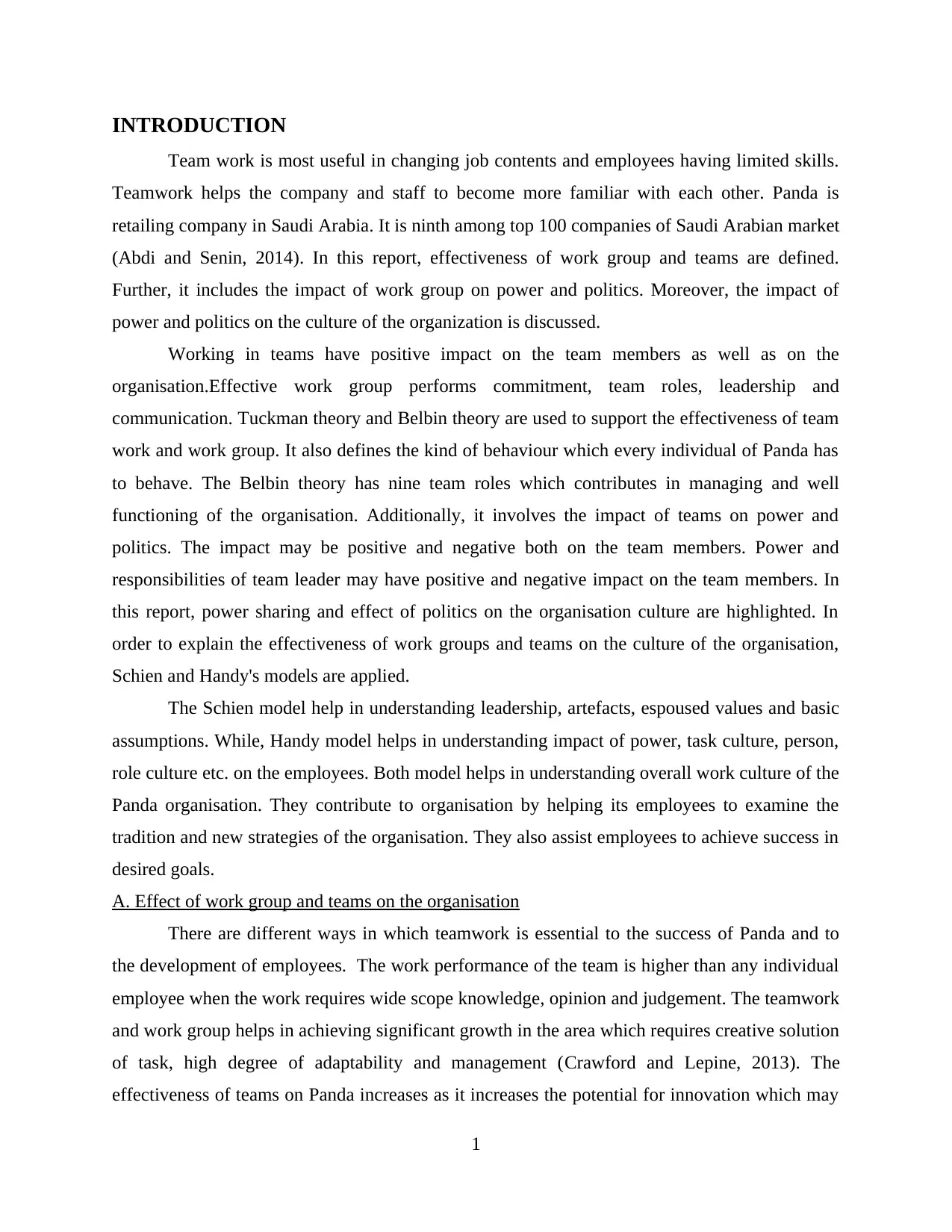
INTRODUCTION
Team work is most useful in changing job contents and employees having limited skills.
Teamwork helps the company and staff to become more familiar with each other. Panda is
retailing company in Saudi Arabia. It is ninth among top 100 companies of Saudi Arabian market
(Abdi and Senin, 2014). In this report, effectiveness of work group and teams are defined.
Further, it includes the impact of work group on power and politics. Moreover, the impact of
power and politics on the culture of the organization is discussed.
Working in teams have positive impact on the team members as well as on the
organisation.Effective work group performs commitment, team roles, leadership and
communication. Tuckman theory and Belbin theory are used to support the effectiveness of team
work and work group. It also defines the kind of behaviour which every individual of Panda has
to behave. The Belbin theory has nine team roles which contributes in managing and well
functioning of the organisation. Additionally, it involves the impact of teams on power and
politics. The impact may be positive and negative both on the team members. Power and
responsibilities of team leader may have positive and negative impact on the team members. In
this report, power sharing and effect of politics on the organisation culture are highlighted. In
order to explain the effectiveness of work groups and teams on the culture of the organisation,
Schien and Handy's models are applied.
The Schien model help in understanding leadership, artefacts, espoused values and basic
assumptions. While, Handy model helps in understanding impact of power, task culture, person,
role culture etc. on the employees. Both model helps in understanding overall work culture of the
Panda organisation. They contribute to organisation by helping its employees to examine the
tradition and new strategies of the organisation. They also assist employees to achieve success in
desired goals.
A. Effect of work group and teams on the organisation
There are different ways in which teamwork is essential to the success of Panda and to
the development of employees. The work performance of the team is higher than any individual
employee when the work requires wide scope knowledge, opinion and judgement. The teamwork
and work group helps in achieving significant growth in the area which requires creative solution
of task, high degree of adaptability and management (Crawford and Lepine, 2013). The
effectiveness of teams on Panda increases as it increases the potential for innovation which may
1
Team work is most useful in changing job contents and employees having limited skills.
Teamwork helps the company and staff to become more familiar with each other. Panda is
retailing company in Saudi Arabia. It is ninth among top 100 companies of Saudi Arabian market
(Abdi and Senin, 2014). In this report, effectiveness of work group and teams are defined.
Further, it includes the impact of work group on power and politics. Moreover, the impact of
power and politics on the culture of the organization is discussed.
Working in teams have positive impact on the team members as well as on the
organisation.Effective work group performs commitment, team roles, leadership and
communication. Tuckman theory and Belbin theory are used to support the effectiveness of team
work and work group. It also defines the kind of behaviour which every individual of Panda has
to behave. The Belbin theory has nine team roles which contributes in managing and well
functioning of the organisation. Additionally, it involves the impact of teams on power and
politics. The impact may be positive and negative both on the team members. Power and
responsibilities of team leader may have positive and negative impact on the team members. In
this report, power sharing and effect of politics on the organisation culture are highlighted. In
order to explain the effectiveness of work groups and teams on the culture of the organisation,
Schien and Handy's models are applied.
The Schien model help in understanding leadership, artefacts, espoused values and basic
assumptions. While, Handy model helps in understanding impact of power, task culture, person,
role culture etc. on the employees. Both model helps in understanding overall work culture of the
Panda organisation. They contribute to organisation by helping its employees to examine the
tradition and new strategies of the organisation. They also assist employees to achieve success in
desired goals.
A. Effect of work group and teams on the organisation
There are different ways in which teamwork is essential to the success of Panda and to
the development of employees. The work performance of the team is higher than any individual
employee when the work requires wide scope knowledge, opinion and judgement. The teamwork
and work group helps in achieving significant growth in the area which requires creative solution
of task, high degree of adaptability and management (Crawford and Lepine, 2013). The
effectiveness of teams on Panda increases as it increases the potential for innovation which may
1
Paraphrase This Document
Need a fresh take? Get an instant paraphrase of this document with our AI Paraphraser
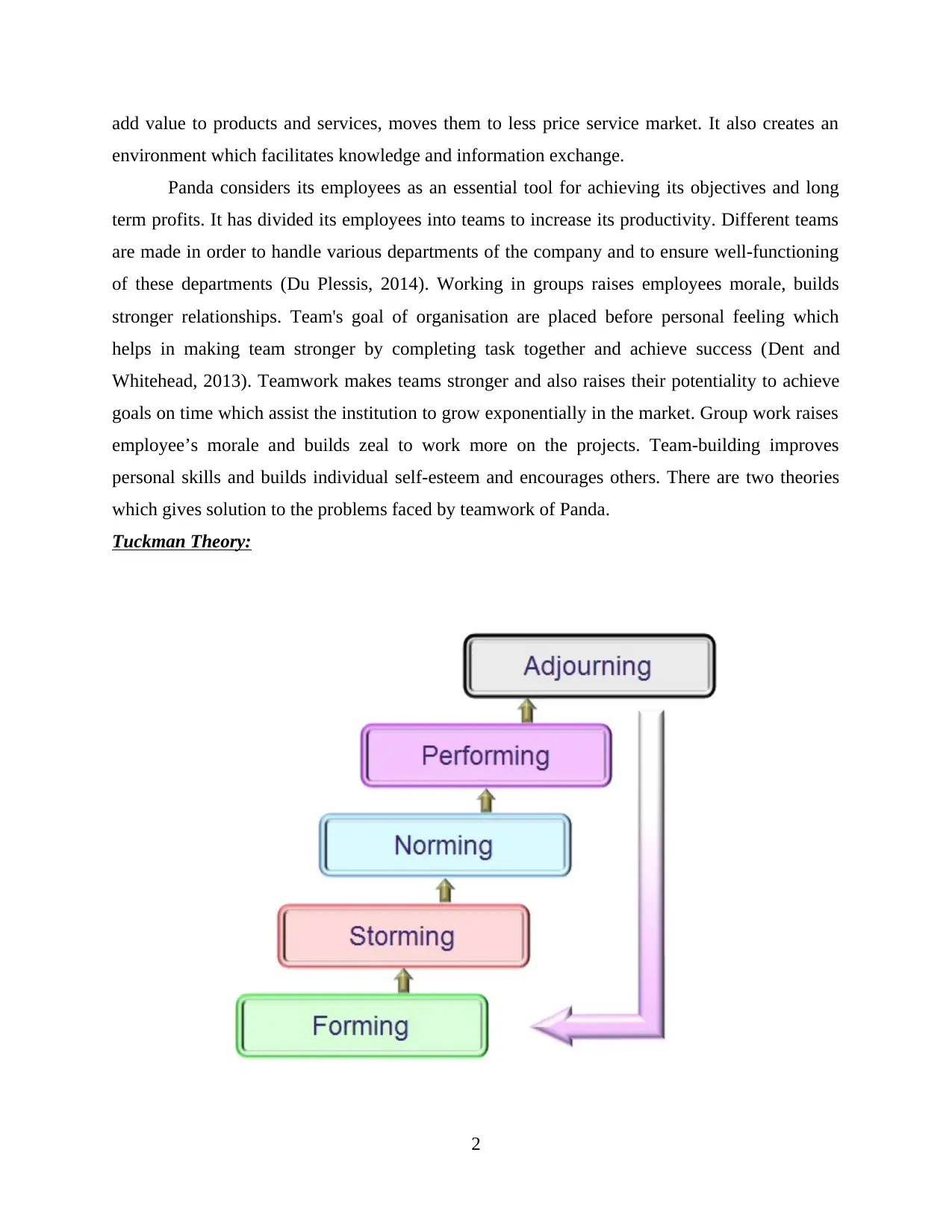
add value to products and services, moves them to less price service market. It also creates an
environment which facilitates knowledge and information exchange.
Panda considers its employees as an essential tool for achieving its objectives and long
term profits. It has divided its employees into teams to increase its productivity. Different teams
are made in order to handle various departments of the company and to ensure well-functioning
of these departments (Du Plessis, 2014). Working in groups raises employees morale, builds
stronger relationships. Team's goal of organisation are placed before personal feeling which
helps in making team stronger by completing task together and achieve success (Dent and
Whitehead, 2013). Teamwork makes teams stronger and also raises their potentiality to achieve
goals on time which assist the institution to grow exponentially in the market. Group work raises
employee’s morale and builds zeal to work more on the projects. Team-building improves
personal skills and builds individual self-esteem and encourages others. There are two theories
which gives solution to the problems faced by teamwork of Panda.
Tuckman Theory:
2
environment which facilitates knowledge and information exchange.
Panda considers its employees as an essential tool for achieving its objectives and long
term profits. It has divided its employees into teams to increase its productivity. Different teams
are made in order to handle various departments of the company and to ensure well-functioning
of these departments (Du Plessis, 2014). Working in groups raises employees morale, builds
stronger relationships. Team's goal of organisation are placed before personal feeling which
helps in making team stronger by completing task together and achieve success (Dent and
Whitehead, 2013). Teamwork makes teams stronger and also raises their potentiality to achieve
goals on time which assist the institution to grow exponentially in the market. Group work raises
employee’s morale and builds zeal to work more on the projects. Team-building improves
personal skills and builds individual self-esteem and encourages others. There are two theories
which gives solution to the problems faced by teamwork of Panda.
Tuckman Theory:
2
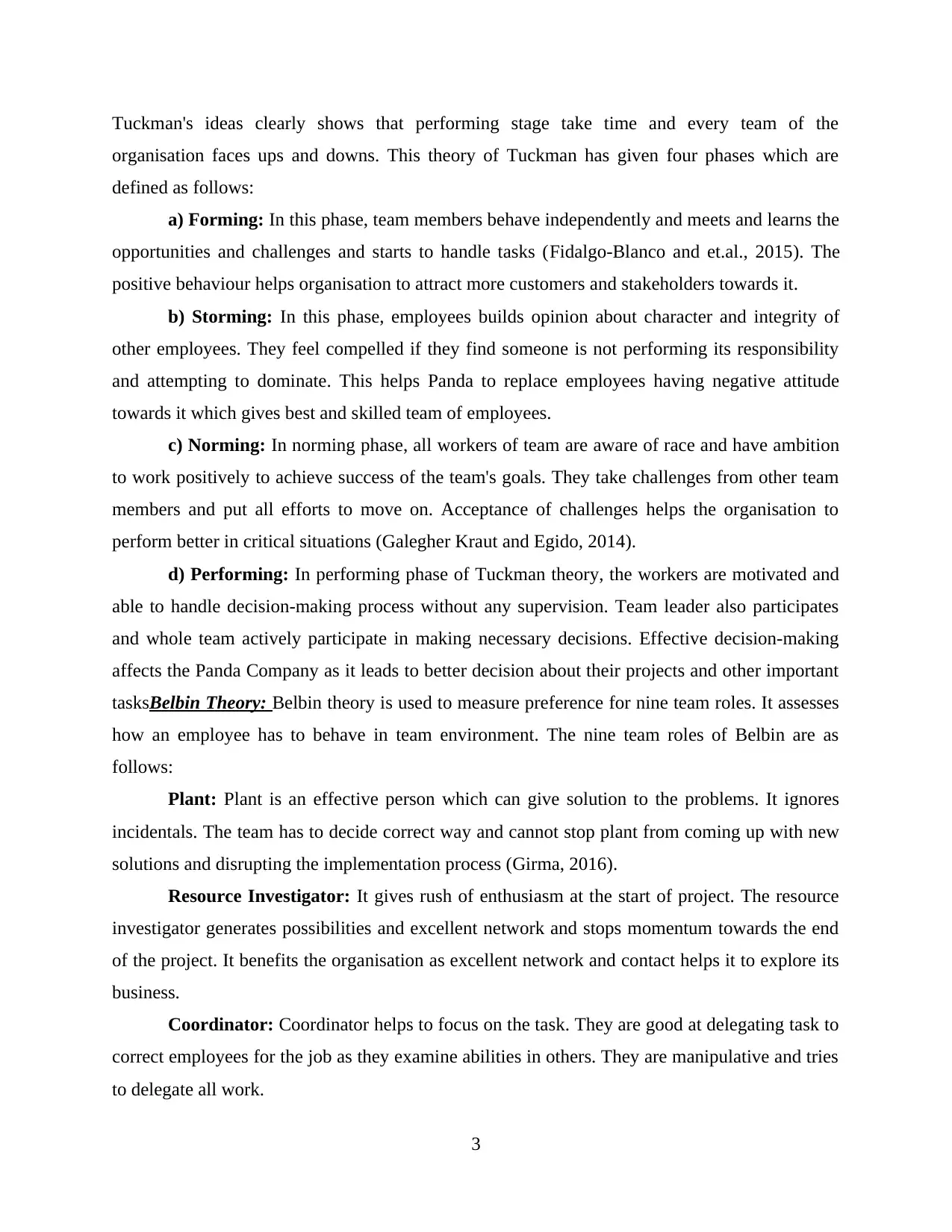
Tuckman's ideas clearly shows that performing stage take time and every team of the
organisation faces ups and downs. This theory of Tuckman has given four phases which are
defined as follows:
a) Forming: In this phase, team members behave independently and meets and learns the
opportunities and challenges and starts to handle tasks (Fidalgo-Blanco and et.al., 2015). The
positive behaviour helps organisation to attract more customers and stakeholders towards it.
b) Storming: In this phase, employees builds opinion about character and integrity of
other employees. They feel compelled if they find someone is not performing its responsibility
and attempting to dominate. This helps Panda to replace employees having negative attitude
towards it which gives best and skilled team of employees.
c) Norming: In norming phase, all workers of team are aware of race and have ambition
to work positively to achieve success of the team's goals. They take challenges from other team
members and put all efforts to move on. Acceptance of challenges helps the organisation to
perform better in critical situations (Galegher Kraut and Egido, 2014).
d) Performing: In performing phase of Tuckman theory, the workers are motivated and
able to handle decision-making process without any supervision. Team leader also participates
and whole team actively participate in making necessary decisions. Effective decision-making
affects the Panda Company as it leads to better decision about their projects and other important
tasksBelbin Theory: Belbin theory is used to measure preference for nine team roles. It assesses
how an employee has to behave in team environment. The nine team roles of Belbin are as
follows:
Plant: Plant is an effective person which can give solution to the problems. It ignores
incidentals. The team has to decide correct way and cannot stop plant from coming up with new
solutions and disrupting the implementation process (Girma, 2016).
Resource Investigator: It gives rush of enthusiasm at the start of project. The resource
investigator generates possibilities and excellent network and stops momentum towards the end
of the project. It benefits the organisation as excellent network and contact helps it to explore its
business.
Coordinator: Coordinator helps to focus on the task. They are good at delegating task to
correct employees for the job as they examine abilities in others. They are manipulative and tries
to delegate all work.
3
organisation faces ups and downs. This theory of Tuckman has given four phases which are
defined as follows:
a) Forming: In this phase, team members behave independently and meets and learns the
opportunities and challenges and starts to handle tasks (Fidalgo-Blanco and et.al., 2015). The
positive behaviour helps organisation to attract more customers and stakeholders towards it.
b) Storming: In this phase, employees builds opinion about character and integrity of
other employees. They feel compelled if they find someone is not performing its responsibility
and attempting to dominate. This helps Panda to replace employees having negative attitude
towards it which gives best and skilled team of employees.
c) Norming: In norming phase, all workers of team are aware of race and have ambition
to work positively to achieve success of the team's goals. They take challenges from other team
members and put all efforts to move on. Acceptance of challenges helps the organisation to
perform better in critical situations (Galegher Kraut and Egido, 2014).
d) Performing: In performing phase of Tuckman theory, the workers are motivated and
able to handle decision-making process without any supervision. Team leader also participates
and whole team actively participate in making necessary decisions. Effective decision-making
affects the Panda Company as it leads to better decision about their projects and other important
tasksBelbin Theory: Belbin theory is used to measure preference for nine team roles. It assesses
how an employee has to behave in team environment. The nine team roles of Belbin are as
follows:
Plant: Plant is an effective person which can give solution to the problems. It ignores
incidentals. The team has to decide correct way and cannot stop plant from coming up with new
solutions and disrupting the implementation process (Girma, 2016).
Resource Investigator: It gives rush of enthusiasm at the start of project. The resource
investigator generates possibilities and excellent network and stops momentum towards the end
of the project. It benefits the organisation as excellent network and contact helps it to explore its
business.
Coordinator: Coordinator helps to focus on the task. They are good at delegating task to
correct employees for the job as they examine abilities in others. They are manipulative and tries
to delegate all work.
3
⊘ This is a preview!⊘
Do you want full access?
Subscribe today to unlock all pages.

Trusted by 1+ million students worldwide
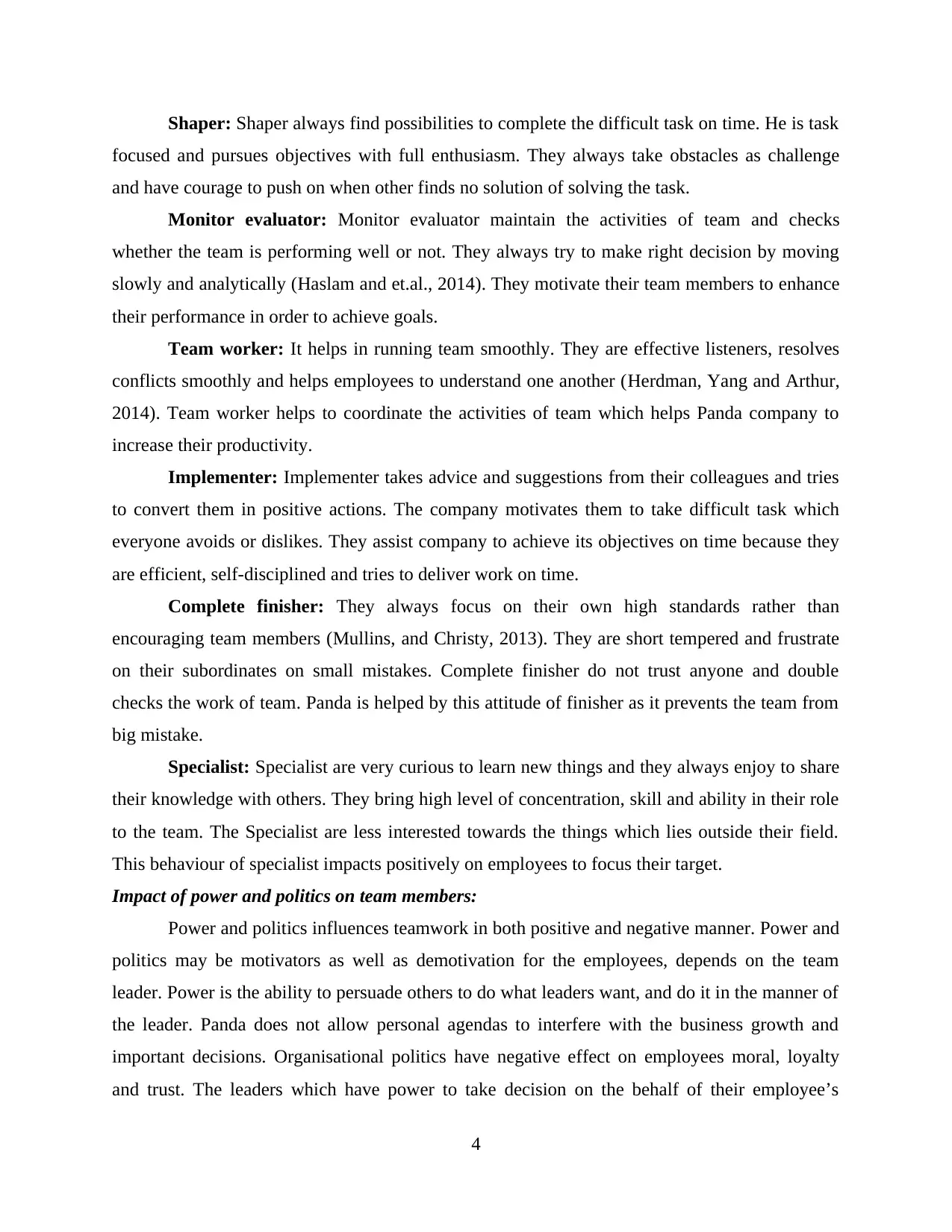
Shaper: Shaper always find possibilities to complete the difficult task on time. He is task
focused and pursues objectives with full enthusiasm. They always take obstacles as challenge
and have courage to push on when other finds no solution of solving the task.
Monitor evaluator: Monitor evaluator maintain the activities of team and checks
whether the team is performing well or not. They always try to make right decision by moving
slowly and analytically (Haslam and et.al., 2014). They motivate their team members to enhance
their performance in order to achieve goals.
Team worker: It helps in running team smoothly. They are effective listeners, resolves
conflicts smoothly and helps employees to understand one another (Herdman, Yang and Arthur,
2014). Team worker helps to coordinate the activities of team which helps Panda company to
increase their productivity.
Implementer: Implementer takes advice and suggestions from their colleagues and tries
to convert them in positive actions. The company motivates them to take difficult task which
everyone avoids or dislikes. They assist company to achieve its objectives on time because they
are efficient, self-disciplined and tries to deliver work on time.
Complete finisher: They always focus on their own high standards rather than
encouraging team members (Mullins, and Christy, 2013). They are short tempered and frustrate
on their subordinates on small mistakes. Complete finisher do not trust anyone and double
checks the work of team. Panda is helped by this attitude of finisher as it prevents the team from
big mistake.
Specialist: Specialist are very curious to learn new things and they always enjoy to share
their knowledge with others. They bring high level of concentration, skill and ability in their role
to the team. The Specialist are less interested towards the things which lies outside their field.
This behaviour of specialist impacts positively on employees to focus their target.
Impact of power and politics on team members:
Power and politics influences teamwork in both positive and negative manner. Power and
politics may be motivators as well as demotivation for the employees, depends on the team
leader. Power is the ability to persuade others to do what leaders want, and do it in the manner of
the leader. Panda does not allow personal agendas to interfere with the business growth and
important decisions. Organisational politics have negative effect on employees moral, loyalty
and trust. The leaders which have power to take decision on the behalf of their employee’s
4
focused and pursues objectives with full enthusiasm. They always take obstacles as challenge
and have courage to push on when other finds no solution of solving the task.
Monitor evaluator: Monitor evaluator maintain the activities of team and checks
whether the team is performing well or not. They always try to make right decision by moving
slowly and analytically (Haslam and et.al., 2014). They motivate their team members to enhance
their performance in order to achieve goals.
Team worker: It helps in running team smoothly. They are effective listeners, resolves
conflicts smoothly and helps employees to understand one another (Herdman, Yang and Arthur,
2014). Team worker helps to coordinate the activities of team which helps Panda company to
increase their productivity.
Implementer: Implementer takes advice and suggestions from their colleagues and tries
to convert them in positive actions. The company motivates them to take difficult task which
everyone avoids or dislikes. They assist company to achieve its objectives on time because they
are efficient, self-disciplined and tries to deliver work on time.
Complete finisher: They always focus on their own high standards rather than
encouraging team members (Mullins, and Christy, 2013). They are short tempered and frustrate
on their subordinates on small mistakes. Complete finisher do not trust anyone and double
checks the work of team. Panda is helped by this attitude of finisher as it prevents the team from
big mistake.
Specialist: Specialist are very curious to learn new things and they always enjoy to share
their knowledge with others. They bring high level of concentration, skill and ability in their role
to the team. The Specialist are less interested towards the things which lies outside their field.
This behaviour of specialist impacts positively on employees to focus their target.
Impact of power and politics on team members:
Power and politics influences teamwork in both positive and negative manner. Power and
politics may be motivators as well as demotivation for the employees, depends on the team
leader. Power is the ability to persuade others to do what leaders want, and do it in the manner of
the leader. Panda does not allow personal agendas to interfere with the business growth and
important decisions. Organisational politics have negative effect on employees moral, loyalty
and trust. The leaders which have power to take decision on the behalf of their employee’s
4
Paraphrase This Document
Need a fresh take? Get an instant paraphrase of this document with our AI Paraphraser
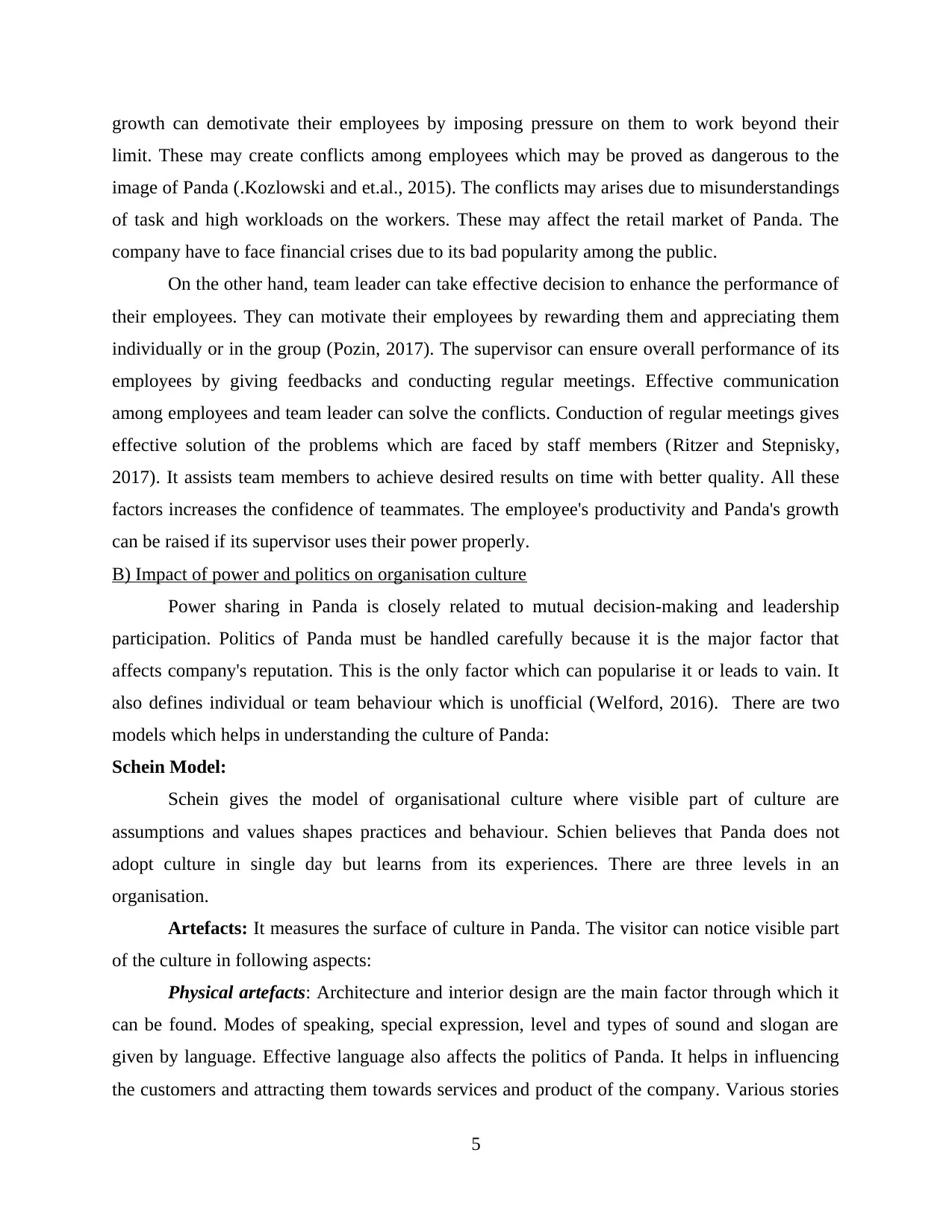
growth can demotivate their employees by imposing pressure on them to work beyond their
limit. These may create conflicts among employees which may be proved as dangerous to the
image of Panda (.Kozlowski and et.al., 2015). The conflicts may arises due to misunderstandings
of task and high workloads on the workers. These may affect the retail market of Panda. The
company have to face financial crises due to its bad popularity among the public.
On the other hand, team leader can take effective decision to enhance the performance of
their employees. They can motivate their employees by rewarding them and appreciating them
individually or in the group (Pozin, 2017). The supervisor can ensure overall performance of its
employees by giving feedbacks and conducting regular meetings. Effective communication
among employees and team leader can solve the conflicts. Conduction of regular meetings gives
effective solution of the problems which are faced by staff members (Ritzer and Stepnisky,
2017). It assists team members to achieve desired results on time with better quality. All these
factors increases the confidence of teammates. The employee's productivity and Panda's growth
can be raised if its supervisor uses their power properly.
B) Impact of power and politics on organisation culture
Power sharing in Panda is closely related to mutual decision-making and leadership
participation. Politics of Panda must be handled carefully because it is the major factor that
affects company's reputation. This is the only factor which can popularise it or leads to vain. It
also defines individual or team behaviour which is unofficial (Welford, 2016). There are two
models which helps in understanding the culture of Panda:
Schein Model:
Schein gives the model of organisational culture where visible part of culture are
assumptions and values shapes practices and behaviour. Schien believes that Panda does not
adopt culture in single day but learns from its experiences. There are three levels in an
organisation.
Artefacts: It measures the surface of culture in Panda. The visitor can notice visible part
of the culture in following aspects:
Physical artefacts: Architecture and interior design are the main factor through which it
can be found. Modes of speaking, special expression, level and types of sound and slogan are
given by language. Effective language also affects the politics of Panda. It helps in influencing
the customers and attracting them towards services and product of the company. Various stories
5
limit. These may create conflicts among employees which may be proved as dangerous to the
image of Panda (.Kozlowski and et.al., 2015). The conflicts may arises due to misunderstandings
of task and high workloads on the workers. These may affect the retail market of Panda. The
company have to face financial crises due to its bad popularity among the public.
On the other hand, team leader can take effective decision to enhance the performance of
their employees. They can motivate their employees by rewarding them and appreciating them
individually or in the group (Pozin, 2017). The supervisor can ensure overall performance of its
employees by giving feedbacks and conducting regular meetings. Effective communication
among employees and team leader can solve the conflicts. Conduction of regular meetings gives
effective solution of the problems which are faced by staff members (Ritzer and Stepnisky,
2017). It assists team members to achieve desired results on time with better quality. All these
factors increases the confidence of teammates. The employee's productivity and Panda's growth
can be raised if its supervisor uses their power properly.
B) Impact of power and politics on organisation culture
Power sharing in Panda is closely related to mutual decision-making and leadership
participation. Politics of Panda must be handled carefully because it is the major factor that
affects company's reputation. This is the only factor which can popularise it or leads to vain. It
also defines individual or team behaviour which is unofficial (Welford, 2016). There are two
models which helps in understanding the culture of Panda:
Schein Model:
Schein gives the model of organisational culture where visible part of culture are
assumptions and values shapes practices and behaviour. Schien believes that Panda does not
adopt culture in single day but learns from its experiences. There are three levels in an
organisation.
Artefacts: It measures the surface of culture in Panda. The visitor can notice visible part
of the culture in following aspects:
Physical artefacts: Architecture and interior design are the main factor through which it
can be found. Modes of speaking, special expression, level and types of sound and slogan are
given by language. Effective language also affects the politics of Panda. It helps in influencing
the customers and attracting them towards services and product of the company. Various stories
5
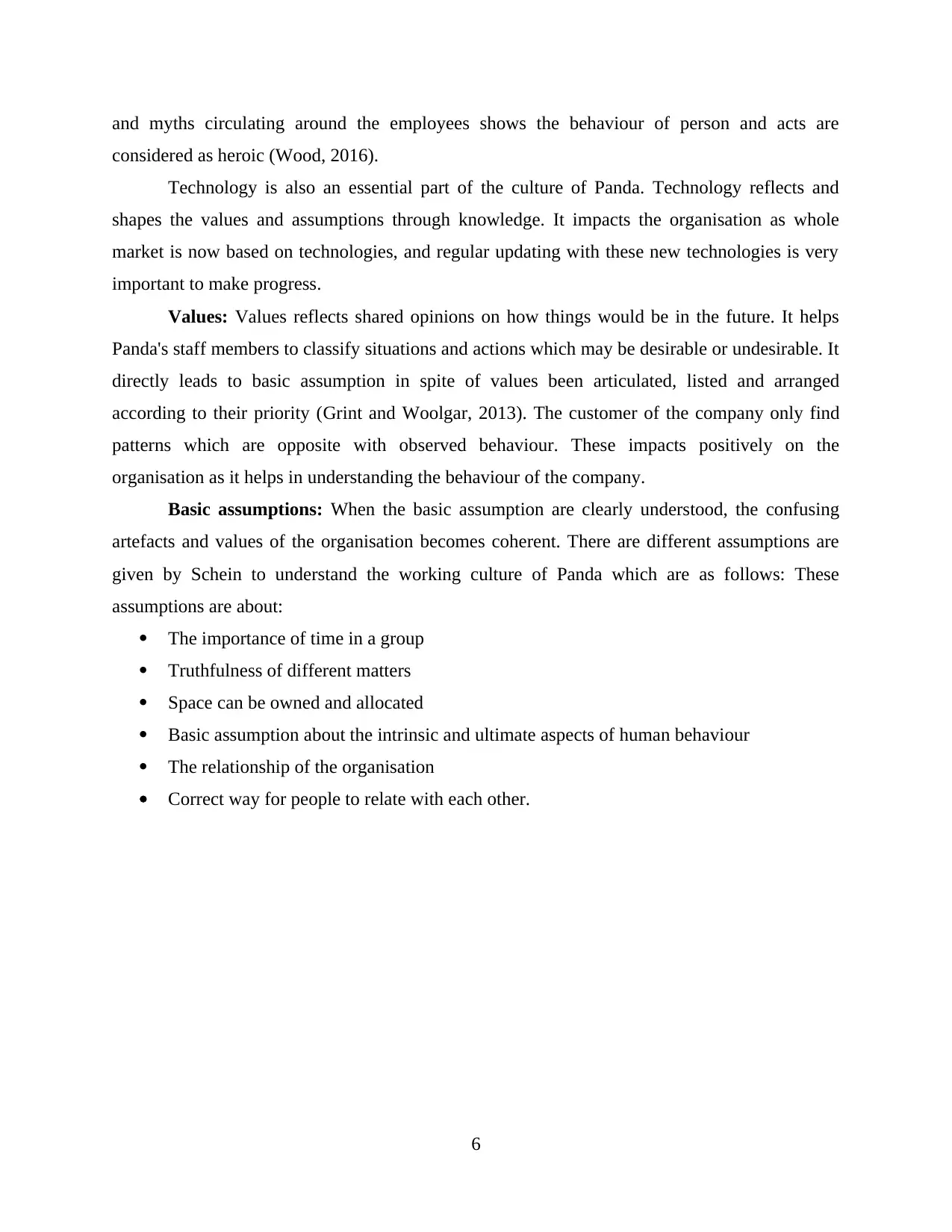
and myths circulating around the employees shows the behaviour of person and acts are
considered as heroic (Wood, 2016).
Technology is also an essential part of the culture of Panda. Technology reflects and
shapes the values and assumptions through knowledge. It impacts the organisation as whole
market is now based on technologies, and regular updating with these new technologies is very
important to make progress.
Values: Values reflects shared opinions on how things would be in the future. It helps
Panda's staff members to classify situations and actions which may be desirable or undesirable. It
directly leads to basic assumption in spite of values been articulated, listed and arranged
according to their priority (Grint and Woolgar, 2013). The customer of the company only find
patterns which are opposite with observed behaviour. These impacts positively on the
organisation as it helps in understanding the behaviour of the company.
Basic assumptions: When the basic assumption are clearly understood, the confusing
artefacts and values of the organisation becomes coherent. There are different assumptions are
given by Schein to understand the working culture of Panda which are as follows: These
assumptions are about:
The importance of time in a group
Truthfulness of different matters
Space can be owned and allocated
Basic assumption about the intrinsic and ultimate aspects of human behaviour
The relationship of the organisation
Correct way for people to relate with each other.
6
considered as heroic (Wood, 2016).
Technology is also an essential part of the culture of Panda. Technology reflects and
shapes the values and assumptions through knowledge. It impacts the organisation as whole
market is now based on technologies, and regular updating with these new technologies is very
important to make progress.
Values: Values reflects shared opinions on how things would be in the future. It helps
Panda's staff members to classify situations and actions which may be desirable or undesirable. It
directly leads to basic assumption in spite of values been articulated, listed and arranged
according to their priority (Grint and Woolgar, 2013). The customer of the company only find
patterns which are opposite with observed behaviour. These impacts positively on the
organisation as it helps in understanding the behaviour of the company.
Basic assumptions: When the basic assumption are clearly understood, the confusing
artefacts and values of the organisation becomes coherent. There are different assumptions are
given by Schein to understand the working culture of Panda which are as follows: These
assumptions are about:
The importance of time in a group
Truthfulness of different matters
Space can be owned and allocated
Basic assumption about the intrinsic and ultimate aspects of human behaviour
The relationship of the organisation
Correct way for people to relate with each other.
6
⊘ This is a preview!⊘
Do you want full access?
Subscribe today to unlock all pages.

Trusted by 1+ million students worldwide
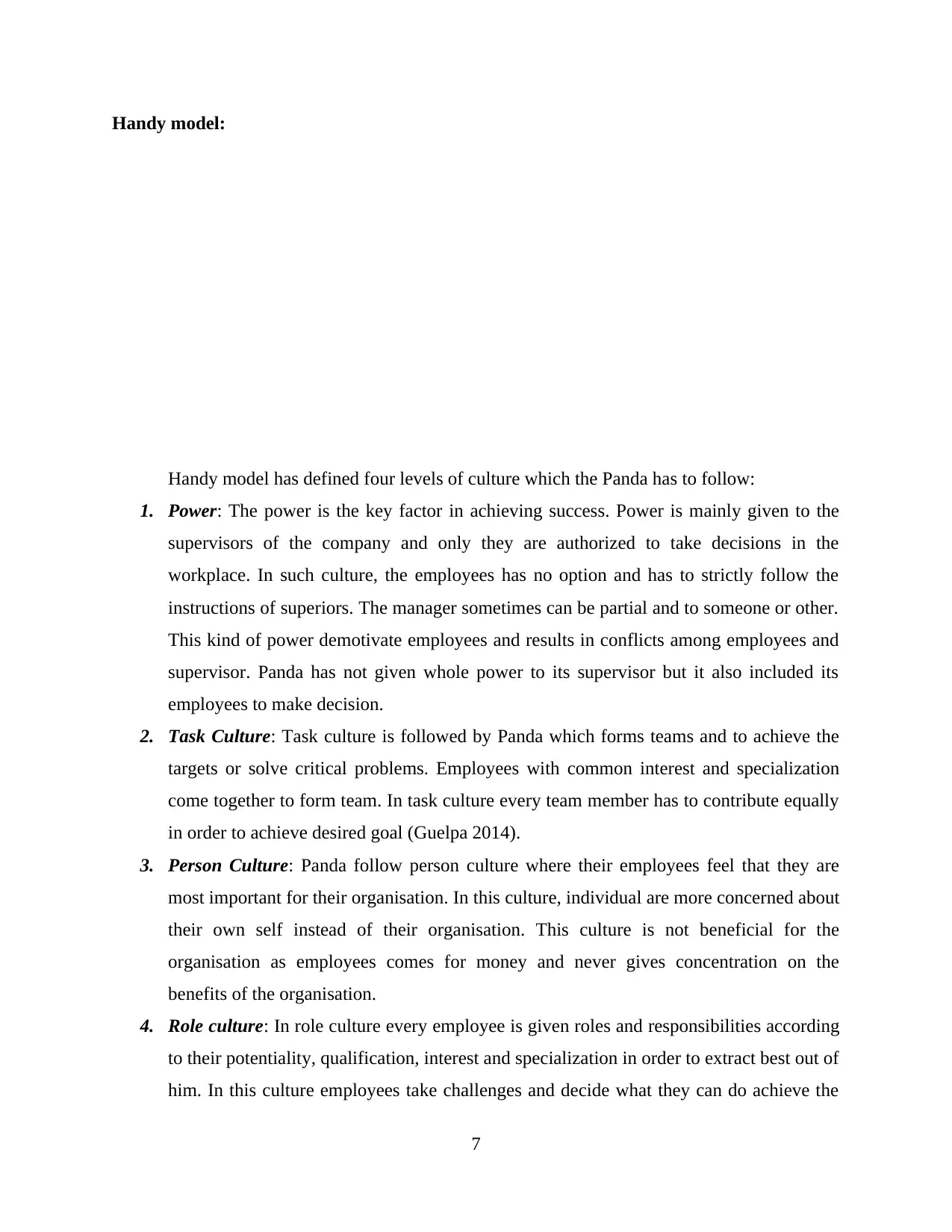
Handy model:
Handy model has defined four levels of culture which the Panda has to follow:
1. Power: The power is the key factor in achieving success. Power is mainly given to the
supervisors of the company and only they are authorized to take decisions in the
workplace. In such culture, the employees has no option and has to strictly follow the
instructions of superiors. The manager sometimes can be partial and to someone or other.
This kind of power demotivate employees and results in conflicts among employees and
supervisor. Panda has not given whole power to its supervisor but it also included its
employees to make decision.
2. Task Culture: Task culture is followed by Panda which forms teams and to achieve the
targets or solve critical problems. Employees with common interest and specialization
come together to form team. In task culture every team member has to contribute equally
in order to achieve desired goal (Guelpa 2014).
3. Person Culture: Panda follow person culture where their employees feel that they are
most important for their organisation. In this culture, individual are more concerned about
their own self instead of their organisation. This culture is not beneficial for the
organisation as employees comes for money and never gives concentration on the
benefits of the organisation.
4. Role culture: In role culture every employee is given roles and responsibilities according
to their potentiality, qualification, interest and specialization in order to extract best out of
him. In this culture employees take challenges and decide what they can do achieve the
7
Handy model has defined four levels of culture which the Panda has to follow:
1. Power: The power is the key factor in achieving success. Power is mainly given to the
supervisors of the company and only they are authorized to take decisions in the
workplace. In such culture, the employees has no option and has to strictly follow the
instructions of superiors. The manager sometimes can be partial and to someone or other.
This kind of power demotivate employees and results in conflicts among employees and
supervisor. Panda has not given whole power to its supervisor but it also included its
employees to make decision.
2. Task Culture: Task culture is followed by Panda which forms teams and to achieve the
targets or solve critical problems. Employees with common interest and specialization
come together to form team. In task culture every team member has to contribute equally
in order to achieve desired goal (Guelpa 2014).
3. Person Culture: Panda follow person culture where their employees feel that they are
most important for their organisation. In this culture, individual are more concerned about
their own self instead of their organisation. This culture is not beneficial for the
organisation as employees comes for money and never gives concentration on the
benefits of the organisation.
4. Role culture: In role culture every employee is given roles and responsibilities according
to their potentiality, qualification, interest and specialization in order to extract best out of
him. In this culture employees take challenges and decide what they can do achieve the
7
Paraphrase This Document
Need a fresh take? Get an instant paraphrase of this document with our AI Paraphraser
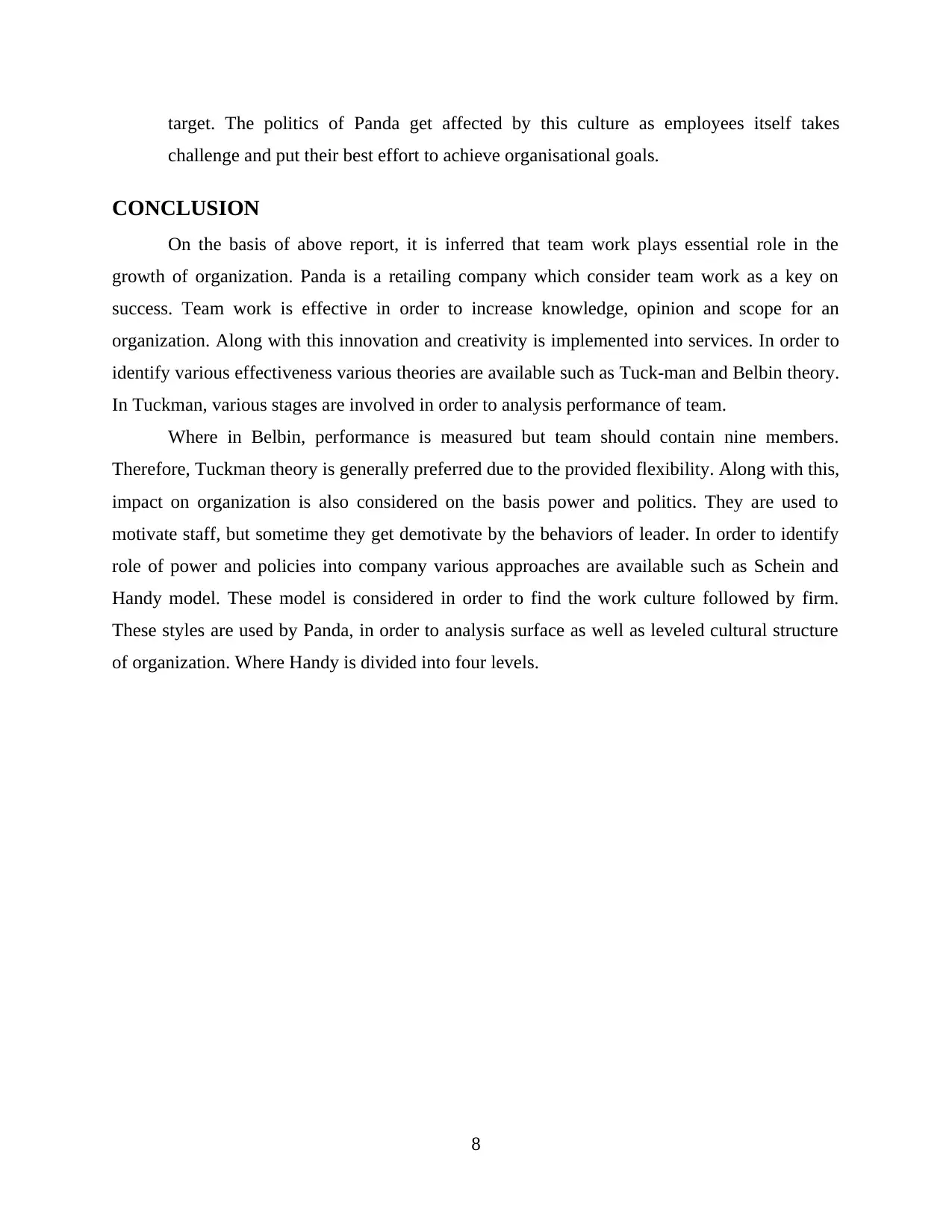
target. The politics of Panda get affected by this culture as employees itself takes
challenge and put their best effort to achieve organisational goals.
CONCLUSION
On the basis of above report, it is inferred that team work plays essential role in the
growth of organization. Panda is a retailing company which consider team work as a key on
success. Team work is effective in order to increase knowledge, opinion and scope for an
organization. Along with this innovation and creativity is implemented into services. In order to
identify various effectiveness various theories are available such as Tuck-man and Belbin theory.
In Tuckman, various stages are involved in order to analysis performance of team.
Where in Belbin, performance is measured but team should contain nine members.
Therefore, Tuckman theory is generally preferred due to the provided flexibility. Along with this,
impact on organization is also considered on the basis power and politics. They are used to
motivate staff, but sometime they get demotivate by the behaviors of leader. In order to identify
role of power and policies into company various approaches are available such as Schein and
Handy model. These model is considered in order to find the work culture followed by firm.
These styles are used by Panda, in order to analysis surface as well as leveled cultural structure
of organization. Where Handy is divided into four levels.
8
challenge and put their best effort to achieve organisational goals.
CONCLUSION
On the basis of above report, it is inferred that team work plays essential role in the
growth of organization. Panda is a retailing company which consider team work as a key on
success. Team work is effective in order to increase knowledge, opinion and scope for an
organization. Along with this innovation and creativity is implemented into services. In order to
identify various effectiveness various theories are available such as Tuck-man and Belbin theory.
In Tuckman, various stages are involved in order to analysis performance of team.
Where in Belbin, performance is measured but team should contain nine members.
Therefore, Tuckman theory is generally preferred due to the provided flexibility. Along with this,
impact on organization is also considered on the basis power and politics. They are used to
motivate staff, but sometime they get demotivate by the behaviors of leader. In order to identify
role of power and policies into company various approaches are available such as Schein and
Handy model. These model is considered in order to find the work culture followed by firm.
These styles are used by Panda, in order to analysis surface as well as leveled cultural structure
of organization. Where Handy is divided into four levels.
8
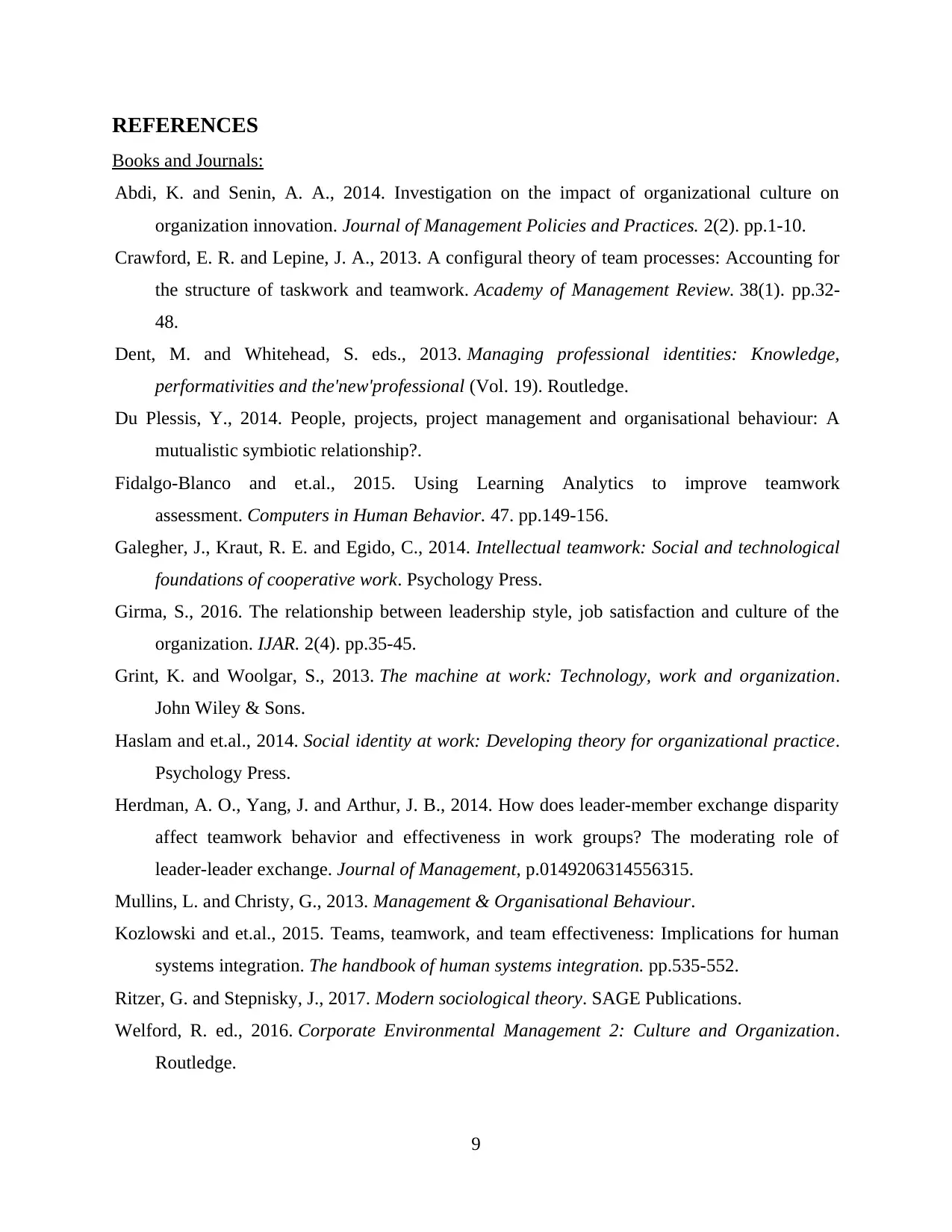
REFERENCES
Books and Journals:
Abdi, K. and Senin, A. A., 2014. Investigation on the impact of organizational culture on
organization innovation. Journal of Management Policies and Practices. 2(2). pp.1-10.
Crawford, E. R. and Lepine, J. A., 2013. A configural theory of team processes: Accounting for
the structure of taskwork and teamwork. Academy of Management Review. 38(1). pp.32-
48.
Dent, M. and Whitehead, S. eds., 2013. Managing professional identities: Knowledge,
performativities and the'new'professional (Vol. 19). Routledge.
Du Plessis, Y., 2014. People, projects, project management and organisational behaviour: A
mutualistic symbiotic relationship?.
Fidalgo-Blanco and et.al., 2015. Using Learning Analytics to improve teamwork
assessment. Computers in Human Behavior. 47. pp.149-156.
Galegher, J., Kraut, R. E. and Egido, C., 2014. Intellectual teamwork: Social and technological
foundations of cooperative work. Psychology Press.
Girma, S., 2016. The relationship between leadership style, job satisfaction and culture of the
organization. IJAR. 2(4). pp.35-45.
Grint, K. and Woolgar, S., 2013. The machine at work: Technology, work and organization.
John Wiley & Sons.
Haslam and et.al., 2014. Social identity at work: Developing theory for organizational practice.
Psychology Press.
Herdman, A. O., Yang, J. and Arthur, J. B., 2014. How does leader-member exchange disparity
affect teamwork behavior and effectiveness in work groups? The moderating role of
leader-leader exchange. Journal of Management, p.0149206314556315.
Mullins, L. and Christy, G., 2013. Management & Organisational Behaviour.
Kozlowski and et.al., 2015. Teams, teamwork, and team effectiveness: Implications for human
systems integration. The handbook of human systems integration. pp.535-552.
Ritzer, G. and Stepnisky, J., 2017. Modern sociological theory. SAGE Publications.
Welford, R. ed., 2016. Corporate Environmental Management 2: Culture and Organization.
Routledge.
9
Books and Journals:
Abdi, K. and Senin, A. A., 2014. Investigation on the impact of organizational culture on
organization innovation. Journal of Management Policies and Practices. 2(2). pp.1-10.
Crawford, E. R. and Lepine, J. A., 2013. A configural theory of team processes: Accounting for
the structure of taskwork and teamwork. Academy of Management Review. 38(1). pp.32-
48.
Dent, M. and Whitehead, S. eds., 2013. Managing professional identities: Knowledge,
performativities and the'new'professional (Vol. 19). Routledge.
Du Plessis, Y., 2014. People, projects, project management and organisational behaviour: A
mutualistic symbiotic relationship?.
Fidalgo-Blanco and et.al., 2015. Using Learning Analytics to improve teamwork
assessment. Computers in Human Behavior. 47. pp.149-156.
Galegher, J., Kraut, R. E. and Egido, C., 2014. Intellectual teamwork: Social and technological
foundations of cooperative work. Psychology Press.
Girma, S., 2016. The relationship between leadership style, job satisfaction and culture of the
organization. IJAR. 2(4). pp.35-45.
Grint, K. and Woolgar, S., 2013. The machine at work: Technology, work and organization.
John Wiley & Sons.
Haslam and et.al., 2014. Social identity at work: Developing theory for organizational practice.
Psychology Press.
Herdman, A. O., Yang, J. and Arthur, J. B., 2014. How does leader-member exchange disparity
affect teamwork behavior and effectiveness in work groups? The moderating role of
leader-leader exchange. Journal of Management, p.0149206314556315.
Mullins, L. and Christy, G., 2013. Management & Organisational Behaviour.
Kozlowski and et.al., 2015. Teams, teamwork, and team effectiveness: Implications for human
systems integration. The handbook of human systems integration. pp.535-552.
Ritzer, G. and Stepnisky, J., 2017. Modern sociological theory. SAGE Publications.
Welford, R. ed., 2016. Corporate Environmental Management 2: Culture and Organization.
Routledge.
9
⊘ This is a preview!⊘
Do you want full access?
Subscribe today to unlock all pages.

Trusted by 1+ million students worldwide
1 out of 13
Related Documents
Your All-in-One AI-Powered Toolkit for Academic Success.
+13062052269
info@desklib.com
Available 24*7 on WhatsApp / Email
![[object Object]](/_next/static/media/star-bottom.7253800d.svg)
Unlock your academic potential
Copyright © 2020–2025 A2Z Services. All Rights Reserved. Developed and managed by ZUCOL.




